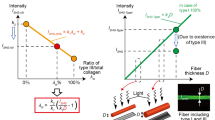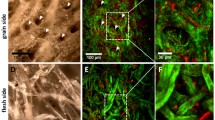Summary
Polarization colors of various purified collagens were studied in fibers of similar thickness. Three different soluble collagens of type I, insoluble collagen type I, lathyritic collagen type I, two p-N-collagens type I, pepsin extract collagen type II, two soluble collagens type III, p-N-collagen type III, and soluble collagen type V were submitted to a routine histopathologic procedure of fixation, preparation of 5-μm-thick sections, staining with Picrosirius red and examination under crossed polars. Polarization colors were determined for thin fibers (0.8 μm or less) and thick fibers, (1.6–2.4 μm). Most thin fibers of collagens and p-N-collagens showed green to yellowish-green polarization collors with no marked differences between the various samples. Thick fibers of all p-N-collagens, lathyritic and normal 0.15 M NaCl-soluble collagens showed green to greenish-yellow polarization colors, while in all other collagens, polarization colors of longer wavelengths (from yellowish-orange to red) were observed. These data suggested that fiber thickness was not the only factor involved in determining the polarization colors of Picrosirius red-stained collagens. Tightly packed and presumably, better aligned collagen molecules showed polarization colors of longer wavelengths. Thus, packing of collagen molecules and not only fiber thickness plays a role in the pattern of polarization colors of Picrosirius red-stained collagens.
Similar content being viewed by others
References
Benditt GP, Eriksen N, Berglund C (1970) Congo red dichroism with dispersed amyloid fibrils, an extrinsic cotton effect. Proc Natl Acad Sci USA 66:1044–1051
Constantine VS, Mowry RW (1968) The selective staining of human dermal collagen. II. The use of Picrosirius Red F3BA with polarization microscopy. J Invest Dermatol 50:419–423
Junquiera LCV, Cossermelli WS, Brentani RR (1978) Differential staining of collagens type I, II and III by Sirius Red and polarization microscopy. Arch Histol Jpn 41:267–274
Junquiera LCV, Bignolas G, Brentani RR (1979) Picrosirius staining plus polarization microscopy, a specific method for collagen detection in tissue sections. Histchem J 11:447–455
Junquiera LCV, Montes GS, Sanchez EM (1982) The influence of tissue section thickness on the study of collagen by the Picrosirius-polarization method. Histochemistry 74:153–156
Wolman M, Bubis JJ (1965) The cause of the green polarization color of amyloid stained with Congo red. Histochem J 4:357–359
Author information
Authors and Affiliations
Rights and permissions
About this article
Cite this article
Dayan, D., Hiss, Y., Hirshberg, A. et al. Are the polarization colors of Picrosirius red-stained collagen determined only by the diameter of the fibers?. Histochemistry 93, 27–29 (1989). https://doi.org/10.1007/BF00266843
Accepted:
Issue Date:
DOI: https://doi.org/10.1007/BF00266843




